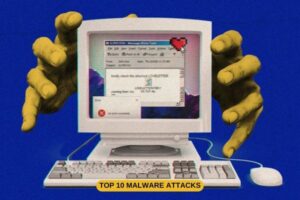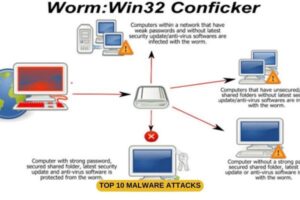Top 10 Malware Attacks in World History

Top 10 Malware Attacks in World History
Top 10 Malware Attacks
Introduction:
Malware, a form of harmful software intentionally created to infiltrate, cause harm, or gain illegal entry into computer systems, has been a persistent cyber threat for several decades. The global landscape has witnessed a wide array of malicious software attacks, encompassing many forms such as worms and ransomware.
In this article, we are going to study these instances of malware that have exhibited a progressive trend toward increased innovation and sophistication. Presented below are some examples that have gained notoriety:
1. ILOVEYOU

The worm, which first emerged in the Philippines in the year 2000, propagated itself by means of email, utilizing an attachment labeled “LOVE-LETTER-FOR-YOU.txt.vbs”. The program’s actions resulted in the overwriting of files and the dissemination of itself to all recipients listed in the user’s address book, leading to substantial financial losses amounting to billions.
2. Conficker

Conficker, a worm that capitalized on weaknesses inside the Windows operating system, was initially identified in 2008. During its zenith, the malware managed to infiltrate a substantial number of computer systems, resulting in the formation of an extensive botnet.
3. Stuxnet

In 2010, the Stuxnet virus was developed with the intention of undermining Iran’s nuclear program. This malicious software successfully inflicted significant harm on Iran’s nuclear centrifuges by manipulating their rotational speed through subtle alterations.
4. CryptoLocker

First appearing in 2013, this form of malicious software known as ransomware employed encryption techniques to render users’ files inaccessible, thereby coercing them into making a payment in order to obtain the decryption key. This particular instance represents an early exemplification of ransomware that achieved notable levels of success.
5. WannaCry

The ransomware, which emerged in 2017, rapidly disseminated on a global scale, employing encryption techniques to render files inaccessible on compromised computer systems, while simultaneously demanding Bitcoin as a kind of monetary extortion. The incident involved the exploitation of a vulnerability in the Windows operating system, resulting in widespread impact on numerous organizations, notably the National Health Service (NHS) in the United Kingdom.
6. Zeus

Discovered in 2007, Zeus is a type of malicious software known as a trojan horse, specifically designed to exploit vulnerabilities in Windows operating systems. Its primary objective is to illicitly obtain sensitive banking information from infected computers through the utilization of man-in-the-browser techniques, such as keyboard recording and form grabbing.
7. Slammer

In the year 2003, a computer worm named Slammer, alternatively referred to as Sapphire, swiftly propagated over around fifty percent of the servers that serve as the foundational infrastructure of the Internet. This widespread infection resulted in significant disruptions and deceleration of network operations on a global scale.
8. Blaster

The Blaster worm, which emerged in 2003, took use of a weakness in the Windows operating system. It quickly propagated and initiated a distributed denial-of-service (DDoS) assault on Microsoft’s updated website.
9. NotPetya

Emerging in the year 2017, the aforementioned malware assumed the guise of ransomware, although exhibited a higher degree of destructiveness. Although the main purpose of the malware was to erase files, it also required a ransom to be paid. The incident resulted in significant disruption, particularly in Ukraine, impacting several sectors such as enterprises and infrastructure.
10. Mydoom

First identified in 2004, Mydoom is an email worm that gained significant recognition due to its rapid propagation, resulting in a notable decrease in global Internet connectivity speeds. Furthermore, it provided attackers with the capability to manipulate compromised computer systems.
The Bottom Line
To wrap up, we would like to state that the historical record of malware attacks serves as a monument to the perpetual game of evasion and pursuit that characterizes the dynamic relationship between cybercriminals and cybersecurity experts. This statement highlights the significance of consistent software updates, user training, and strong cybersecurity systems.
Furthermore, if a person has developed a keen interest in the world of cybersecurity and ethical hacking then the same can nicely join Craw Security, the Best Cybersecurity Training Institute in India, and opt for the world-class Ethical Hacking Course by this magnificent institute.

















